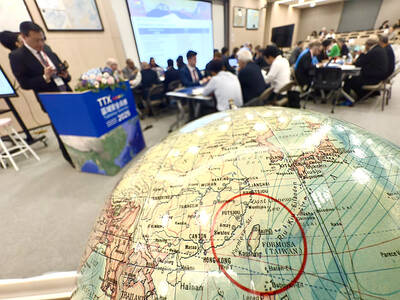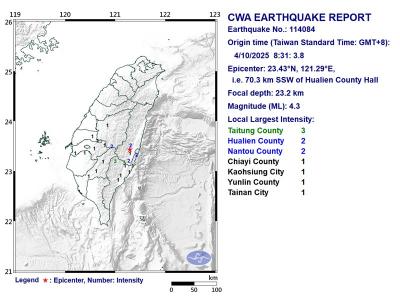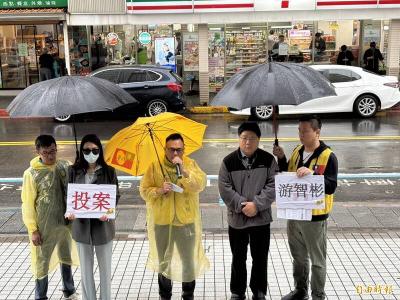An exhibition commemorating South Korea’s Gwangju Uprising opened in Taipei yesterday.
To mark the 39th anniversary of the South Korean pro-democracy movement, as well as the 40th anniversary of Taiwan’s Kaohsiung Incident, the Transitional Justice Commission invited organizers of the Gwangiu exhibition to present it in Taiwan, Democratic Progressive Party (DPP) Legislator Lin Ching-yi (林靜儀) told a news conference.
The Kaohsiung Incident, also known as the Formosa Incident, took place on Dec. 10, 1979, when a demonstration organized by opposition politicians and Formosa Magazine to commemorate Human Rights Day turned violent.

Photo: Chien Jung-fong, Taipei Times
Members of the crowd unknown to the organizers — and widely believed to have been agents provocateurs — began attacking police, which was followed by the then-Chinese Nationalist Party (KMT) government arresting and jailing a group of political dissidents.
The Gwangju Uprising — also called the May 18 Democratic Uprising — against martial law took place in Gwangju, South Korea, in 1980.
More than 200 people died or went missing, official figures showed, while advocates have said that the toll might have been three times higher.
Commission Acting Chairwoman Yang Tsui (楊翠) said that the agency saw the exhibition held by the South Korean National Assembly during a visit in June and was inspired by its efforts in exhibiting historical wounds to create an opportunity for forgiveness and reconciliation.
The exhibition demonstrated how to implement transitional justice at the right pace, she added.
Victims of the uprising have witnessed public apologies by the South Korean government, DPP legislator-at-large nominee Fan Yun (范雲) said, adding that several movies documenting the democratic process and independent reports about the female victims in the uprising have been made.
On the other hand, Taiwan does not have any movie dedicated to the Kaohsiung Incident, let alone independent investigation reports about female victims, she said.
Nor has anyone apologized for the incident and transitional justice has not been achieved, as it remains unanswered who should be held accountable for turning the peaceful protest into a violent uprising, she added.
May 18 Archives researcher Lee Deok-jae said that after martial law was imposed in South Korea, soldiers entered Gwangju and began massacring people.
The uprising gave rise to the pro-democracy movement in South Korea, as its ripple effects spread not only within Gwangju, but across the nation, Lee said.
The 228 Massacre in Taiwan must have been similar, he added.
The 228 Massacre refers to an uprising that was ignited on Feb. 27, 1947, against the then-KMT regime and a resulting crackdown that left tens of thousands of people dead and launched the White Terror era.
May 18 Memorial Foundation Education Culture and Department manager Gwon Hyeok-min said that she was in Gwangju when the uprising started, which was why she can sympathize with victims of the 228 Incident and the Kaohsiung Incident, as she understood how it felt to be called a “rioter.”
Taiwan’s 40-year-long government oppression during the Martial Law era can have devastating effects on the mental health of its victims, Gwon said, expressing the hope that efforts to implement transitional justice could heal the trauma.
The exhibition runs until Dec. 22 at an open space across from the National Audit Office on Taipei’s Hangzhou N Road. Admission is free.

DEFENSE: The National Security Bureau promised to expand communication and intelligence cooperation with global partners and enhance its strategic analytical skills China has not only increased military exercises and “gray zone” tactics against Taiwan this year, but also continues to recruit military personnel for espionage, the National Security Bureau (NSB) said yesterday in a report to the Legislative Yuan. The bureau submitted the report ahead of NSB Director-General Tsai Ming-yen’s (蔡明彥) appearance before the Foreign and National Defense Committee today. Last year, the Chinese People’s Liberation Army (PLA) conducted “Joint Sword-2024A and B” military exercises targeting Taiwan and carried out 40 combat readiness patrols, the bureau said. In addition, Chinese military aircraft entered Taiwan’s airspace 3,070 times last year, up about

A magnitude 4.3 earthquake struck eastern Taiwan's Hualien County at 8:31am today, according to the Central Weather Administration (CWA). The epicenter of the temblor was located in Hualien County, about 70.3 kilometers south southwest of Hualien County Hall, at a depth of 23.2km, according to the administration. There were no immediate reports of damage resulting from the quake. The earthquake's intensity, which gauges the actual effect of a temblor, was highest in Taitung County, where it measured 3 on Taiwan's 7-tier intensity scale. The quake also measured an intensity of 2 in Hualien and Nantou counties, the CWA said.

The Overseas Community Affairs Council (OCAC) yesterday announced a fundraising campaign to support survivors of the magnitude 7.7 earthquake that struck Myanmar on March 28, with two prayer events scheduled in Taipei and Taichung later this week. “While initial rescue operations have concluded [in Myanmar], many survivors are now facing increasingly difficult living conditions,” OCAC Minister Hsu Chia-ching (徐佳青) told a news conference in Taipei. The fundraising campaign, which runs through May 31, is focused on supporting the reconstruction of damaged overseas compatriot schools, assisting students from Myanmar in Taiwan, and providing essential items, such as drinking water, food and medical supplies,

New Party Deputy Secretary-General You Chih-pin (游智彬) this morning went to the National Immigration Agency (NIA) to “turn himself in” after being notified that he had failed to provide proof of having renounced his Chinese household registration. He was one of more than 10,000 naturalized Taiwanese citizens from China who were informed by the NIA that their Taiwanese citizenship might be revoked if they fail to provide the proof in three months, people familiar with the matter said. You said he has proof that he had renounced his Chinese household registration and demanded the NIA provide proof that he still had Chinese